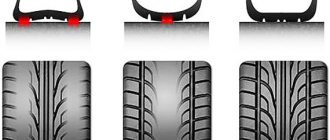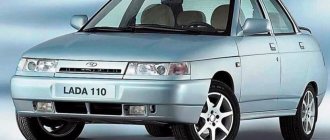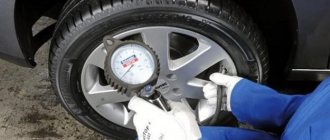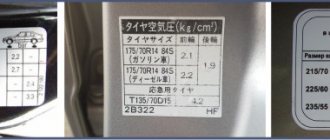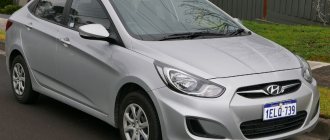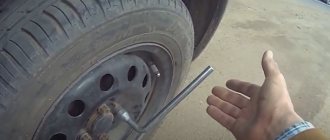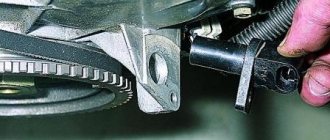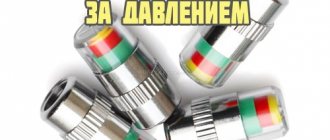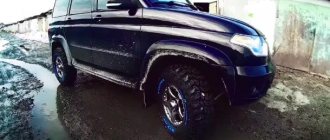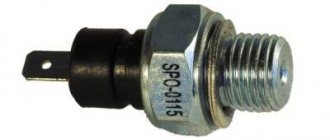Published: 01/28/2021
- Commenting Rules
- Optimal tire pressure
- Optimal car tire pressure
- Recommended size of Niva 4x4 wheels and tires
- Correct tire pressure
- Consequence of violation of regulatory pressure Niva 21213
- What pressure should be in the tires of a Niva Chevrolet car?
- The influence of tire pressure on basic driving characteristics
- Calculation of the recommended value
- Custom Options
- Instruments for checking the degree of pumping
- Which wheels are better to install on Lada 4×4
- Summary table of Niva tire pressure
Optimal tire pressure
Tire pressure is a value that depends on many factors:
- The model and, as a consequence, the carrying capacity and weight of the vehicle.
- Wheel diameter.
- Tire type.
- Season.
- Features of driving a car.
- Quality of the road surface.
Specific indicators will depend on the combination of all these factors, so the pressure in the tires of a passenger car is not a constant value. At the same time, car manufacturers indicate pressure standards for each car model in the operating manual.
For passenger cars, on average, the recommended pressure in the front wheels is 2.2 atmospheres, in the rear wheels - 2 atmospheres. But such parameters are not used in heavy cars and SUVs. Some manufacturers recommend increasing the pressure in the rear tires at maximum vehicle load to 0.8 atmospheres.
Check frequency
Often the driver remembers the tire pressure only 2 times a year - when changing tires at a tire shop before the next summer or winter season.
However, the wheel is not a completely sealed device and over time, depending on the degree of wear of the rubber, air may escape. Ideally, you should check the amount of air before each trip. But the most optimal control mode would be to check once every 2-3 weeks and before long trips.
In spring and autumn, when sudden temperature changes are possible, it is better to check more often. When the temperature changes by 10˚C, the air pressure changes by at least 0.1 bar.
Optimal car tire pressure
The main task of car tires is to provide effective traction between the car and the road. With normal air pressure in the tire, the load in the contact patch of the wheel with the road is distributed evenly, due to which tire wear occurs evenly, the car handles well and fuel consumption is within normal limits.
There are three possible scenarios in which the tire pressure will not be optimal:
- Increased pressure (tires overinflated);
- Low pressure (tires underinflated);
- Different pressure in all wheels.
Check the tire pressure with a special tire pressure gauge. This should only be done on cold tires, that is, before leaving the parking lot or garage.
If deviations from the normal pressure are detected in any of the tires (see the table below for what pressure should be in the tires of your passenger car), such a wheel must either be inflated or excess air released from it - that is, the pressure must be adjusted to norm. In one of our articles, we already talked about which car compressor is best for inflating tires.
It is worth noting that the tire pressure in winter should be exactly the same as in summer. But due to the sharp temperature change, in winter, monitoring the air pressure in the wheels needs to be approached more responsibly.
It is better to inflate your tires outside. Also, do not forget to check the tire pressure when there are significant changes in ambient temperature, and if necessary, adjust it:
- if it gets cold outside, the pressure in the tires will decrease,
- and when it gets warmer, it will rise.
It should also be remembered that while the car is moving, the tires heat up, the air in them expands, and the pressure increases, and the handling and braking properties change.
Increased tire pressure
With increased tire pressure, the load at the point of contact of the wheel with the road acts to a greater extent on the central part of the tire tread, thereby causing uneven wear of the tire.
On overinflated wheels, the car brakes worse! This happens because if the tires are overinflated, the contact patch with the road decreases, which means the friction force that keeps the car from sliding decreases. At the same time, the braking distance increases noticeably.
In just twenty minutes of driving, taking turns as aggressively as possible, the pressure in the car’s tires can increase by 0.5 atmospheres. And on long trips at high speed, the pressure in the tires can increase to 4-5 atmospheres. And modern tires are designed for this.
But if the tire has a hernia or cut, it can heat up and explode while driving. But on the road it’s a disaster.
Low tire pressure
Wheels lowered to just half an atmosphere change the behavior of the car and become unusable much earlier than expected. When the pressure is low, the load on the tire surface is distributed unevenly. In this case, the sidewalls of the tire where the tire contacts the road are subject to increased wear.
The sidewalls of flat tires are softer and bend when you turn the steering wheel. The trajectory of the wheel and tire do not match, so the car responds to the steering wheel late.
Moreover, if the tire pressure is reduced, the wheel may even come off during a sharp turn.
Therefore, it is very important to regularly check tire pressure and maintain it within normal limits.
This is especially true in winter, since in cold weather the tire pressure can easily drop by 0.3 (or even 0.5) atmospheres.
It is also worth keeping in mind that low air pressure in the wheels leads to increased fuel consumption. Just in case, we remind you that our website has an excellent selection of tips on how to reduce fuel consumption in a car - be sure to read it, you will probably find something new for yourself.
Different pressure in car tires
The most common situation among drivers is when the pressure in all wheels is different. There can be many reasons, for example:
- Faulty spool valves;
- Uneven tire wear;
- Or perhaps you caught a nail with the wheel.
During emergency braking, in this case, the coefficient of road adhesion between inflated and lowered wheels will be different, which with a high degree of probability will lead to the car skidding or turning across the road.
If the car starts to pull even a little to the side, there is a reason to check how the tires are inflated. And remember that tires don’t last forever. Even very good tires need care.
Why is it necessary to control?
Reduced or increased air content leads to a change in the contact surface of the tires with the road surface. This leads to various consequences.
For high blood pressure:
- road grip decreases
- road stability decreases
- tire tread wears off unevenly, more in the middle
- the shock-absorbing properties of the wheel are reduced
- the risk of damaging the tires when falling into a hole increases
- braking distance increases
At low pressure:
- increased contact area with asphalt
- fuel consumption increases
- the tread wears out faster and unevenly, more at the edges
- car control deteriorates
- decreased stability when turning and changing lanes at high speed
- the chance of tire and rim damage increases when a wheel falls into a hole
The greatest danger comes from different pressures in all wheels. While driving, the vehicle “steers” towards the wheel with the lowest value.
Recommended size of Niva 4x4 wheels and tires
| rim width (inches) | rim offset (ET), mm** | front wheels | rear wheels |
185/75 R16 92Q 95T
5J*** 58*** 0.21 (2.1) 0.19 (1.9) 5J*** 58*** 0.21 (2.1) 0.19 (1.9)
Allowed to be installed in operation
195/70 R15 92Q, T
205/70 R15 95Q, S, T
- * Speed indices: Q – up to 160 km/h, S – up to 180 km/h, T – up to 190 km/h. Load capacity indices: 85 – 515 kg, 88 – 560 kg, 92 – 630 kg, 95 – 690 kg.
- **Rim offset (ET) is the distance from the mating plane of the disc to the middle of the rim.
- In operation, it is allowed to install wheels with a rim width of 5 1/2J and a rim offset of 48-58 mm.
- R is not a radius, but a designation of the radius of the tire, and the number is the diameter of the rim in inches.
Table of standards for various tires
| Tire type | Front, atm | Rear, atm |
| 205/70 R15 | 2.1 | 2.1 |
| 205/75 R15 | 2.1 | 2.1 |
| 215/65 R16 | 2.2 | 2.2 |
Attention!
The pressure in the rear tires should be approximately 0.3 - 0.5 bar higher if you plan to carry a heavy load.
In winter, you can slightly reduce the amount of air to increase the tire contact area with the road.
So, dear car enthusiasts, do not forget to regularly check the tire pressure, because the safety of you and your loved ones depends on it.
Correct tire pressure
What should be the operating pressure in tires is indicated by both car manufacturers and tire manufacturers. If the car is equipped with wheels of the specified size, when checking the pressure, the owner must first of all follow the recommendations of the car manufacturer. This is explained very simply. A car is born in design bureaus and tested as one unit along with tires, so suspension comfort, cross-country ability on different roads, fuel consumption, dynamics and other parameters are ensured taking into account a certain pressure in them.
The characteristics of the tires, in turn, depend on this indicator - rolling resistance, braking distance, lateral slip, etc. Accordingly, the technical characteristics of the car will differ from those stated in the operating manual. Tire manufacturers are only suppliers of components, so they adjust the characteristics of their products to the parameters of cars of different classes. As for the pressure indicated on some tires, this information implies the value at which they remain operational, do not lose their properties and do not collapse.
Sometimes a car is “re-shoeed” with non-standard tires - high or low profile. In this case, the pressure in them must be maintained according to the recommendations of their manufacturer. A similar situation may occur when installing winter tires, since their design differs significantly from summer tires, which means the operating pressure in them is different. In this regard, it is better to buy tires in specialized stores, where salespeople can give qualified recommendations.
There are two main factors that most often and significantly affect tire pressure: temperature and load. Many people do not know about this, so when the weather changes, accompanied by large temperature changes, the tire pressure is not monitored. And in vain. If at a temperature of +5°C the tire pressure (175/70R13) is brought to normal (for example, 2.0 bar), then after warming up to +25°C it can jump to 2.8 bar. After loading the car to the maximum, this same figure can increase to 3.3 - 3.6 bar. On a sunny summer day, the temperature of the asphalt hot in the sun is also added to this, as well as the heating of the wheel as a result of the work of friction forces, as a result of which the pressure can go beyond the maximum permissible value.
How to measure tire pressure correctly
The procedure for measuring tire pressure is not as simple as it might seem at first glance. As you probably already understood, when the car is partially and fully loaded, the pressure in the tires is different. In vehicle operating manuals, operating pressure values are more often indicated for a partial load (one to three people) and less often for a full load (more than three people).
Almost all car owners, as a rule, know only one meaning - the first one. Rarely does anyone think about the fact that after a full load it increases, much less what it should be like. This is where the danger lies. Imagine that you loaded the car to capacity and somewhere on the highway you wanted to measure the pressure, just to be sure. Instead of the required two atmospheres (bar, kgf/sq. cm), the pressure gauge will show all three, which, naturally, will be higher than normal. There is only one reaction to this - bring the pressure to normal, that is, lower the tires. As a result, a loaded car will move on half-flat wheels, which entails a decrease in their service life and an increase in fuel consumption.
VAZ cars can be considered one of the most famous brands in the post-Soviet space. Today you can find both old VAZ-2106 and 2107 models. Samara 2109 and 21099 are quite common. Fans of the domestic automobile industry today purchase more modern models: VAZ 2110, 2112, 2114 and 2115
This suggests that even with the appearance on the market of a large number of affordable foreign cars, cars from the Volzhsky plant have not ceased to be in demand among car enthusiasts. It is important to always know the tire pressure of your car
Measuring methods
It is impossible to determine the amount of air in tires without special instruments. Outwardly, it turns out to notice only some deformations, the cause of which was incorrect pressure. As a result, some depression may appear on the rubber itself and the tread pattern may change.
You can measure tire pressure on a Chevrolet Niva only using pressure gauges. There are two types of such devices:
- mechanical (switch);
- electronic.
Electronic pressure gauge for cars
The percentage of error for mechanical pressure gauges is higher, but not significant. In everyday life, they can be used with the same success as their electronic counterparts. Electric pressure gauges provide the most accurate results. The error indicator in this case is no more than 0.05 bar. Today this is the most accurate device for measuring tire pressure not only on Niva, but also on other cars.
It should also be noted that in winter the tire pressure level can be more or less accurately measured only with an electronic pressure gauge.
Consequence of violation of regulatory pressure Niva 21213
If you do not adhere to the described operating requirements, the following will happen:
- Increased load on chassis parts will lead to premature wear and failure.
- Fuel consumption will increase due to the fact that the flat tire has a larger contact area. The protector, having opened, prevents movement. The engine will need to develop more power.
- The tires will wear out quickly. The reason for this is the increased contact patch with the road surface. By the way, lateral abrasion indicates that the tire is flat, and it is necessary to urgently take measurements and eliminate the cause.
- The risk of getting into an accident increases significantly, especially if you overinflate your tires in winter.
But if you monitor the amount of air in the slopes, the Chevrolet Niva will always remain a safe car with outstanding cross-country characteristics.
| 105 posts on previous pages |
Reg.: 07/07/2005 Messages: 948 From: Moscow Age: 38 Car: 21213, 1999
Reg.: 12/06/2004 Topics / Messages: 628 / 51730
Reg.: 02/08/2006 Topics / Messages: 17 / 1847 From: Ufa Age: 44 Car: VAZ 21312 1.8 carb 1998 clutch 2123. Renault KAPTUR Style 2016 Manual transmission6, 2.0l, 4WD
Reg.: 05/06/2005 Topics / Messages: 4 / 520 From: Moscow -> Slovakia Age: 48 Car: 21213 99 Kama Flame (slides on ice!) -> Mitsu Outlander 2.0 4wd manual transmission
“in a circle” means everything without exception. For example, “replacing the suspension in a circle” – replacing everything in the suspension that changes; “pumping in a circle” – pumping all the wheels
“for the circle” - in full.” “for the circle it was 20 kilo rubles” - the total amount, including all expenses, was 20 thousand rubles.
(We had a slang dictionary somewhere. Mods, maybe add it there?)
it's bullshit. I even doubted whether I was pumping up the Kama-flame 2.1 correctly in front of the 1.9 rear. By the way, if it lowers to 1.8 in front, then the car begins to consume gasoline like a tank and acquires dynamics, as if that same tank was hanging on a cable. So I think that maybe the service people are right and we should pump it a little more.
Does anyone have a link to the Kama-flame factory page?
Added after 6 minutes 11 seconds:
found. Factory recommendation for Kama-flame:
By the way, for Kama tires you can get this information by selecting the appropriate tire here: https://www.shina-kama.ru/? > Added after 48 seconds:
Today I’ll try to pump it up to 2.3 (since the load is not maximum), I’ll tell you the results.
Reg.: 06/25/2007 Messages: 146 From: Ryazan Age: 43 Car: Krasnaya NIVA 2121, 1994, Lovato HBO; Subaru FORESTER, 2003, atmospheric, manual transmission, LPG - hodgepodge.
Reg.: 05/06/2005 Topics / Messages: 4 / 520 From: Moscow -> Slovakia Age: 48 Car: 21213 99 Kama Flame (slides on ice!) -> Mitsu Outlander 2.0 4wd manual transmission
Reg.: 06/25/2007 Messages: 146 From: Ryazan Age: 43 Car: Krasnaya NIVA 2121, 1994, Lovato HBO; Subaru FORESTER, 2003, atmospheric, manual transmission, LPG - hodgepodge.
Reg.: 02/08/2006 Topics / Messages: 17 / 1847 From: Ufa Age: 44 Car: VAZ 21312 1.8 carb 1998 clutch 2123. Renault KAPTUR Style 2016 Manual transmission6, 2.0l, 4WD
Reg.: 04/24/2006 Topics / Messages: 6 / 1957 From: St. Petersburg Age: 28 Car: NIVA 2003, TOYOTA CARINA II
Reg.: 12/06/2004 Topics / Messages: 628 / 51730
A significant increase in tire pressure compared to the norm reduces rolling resistance by reducing the contact patch, as a result of which fuel consumption decreases and vehicle mileage increases. However, this increases the braking distance, as the adhesion properties of the tires decrease; Tires start to slip and skid on wet roads. This is on roads with smooth hard surfaces. When driving on bumpy roads, the smoothness of the ride deteriorates: all the unevenness of the road, especially on turns, is transmitted with strong impacts to the steering parts, suspension, and wheel hub bearings.
With increased tire pressure in the spring, when stones and crushed stones begin to melt on the roads, tread breakdowns become significantly more frequent.”
It's all strange. There is a mainstream opinion and there are other opinions. I personally feel much more comfortable with lower tire pressure (I-511). They write that reducing the pressure by 20% (and this is from 2.0 to 1.6, for example) leads to a reduction in tire life by only 30% (let’s say it will be not 3 years, but 2). If we take into account that in winter they are winter and in summer they are summer, then they are more likely to dry out than to be demolished even at low pressure.
Am I speaking correctly or is there a catch somewhere? Even in this thread, a table was quoted and it turned out that a pressure of 1.6 on an unloaded car is suitable for the Niva.
“At low temperatures, the tire pressure recorded by the tire pressure gauge may be lower than it actually is. If, for example, at normal temperature (18-20 C) the tire is inflated to 2 atm, then at 8 C the pressure gauge will show 1.9 atm. Consequently, the readings from the device may be misinterpreted when measuring pressure in winter. Therefore, you should not pump up your tires in winter.”
". In winter studded tires, the pressure should be maintained at approximately 0.2 atm. more than conventional tires."
But from another site about Suzuka:
And here’s another good article on the topic: people changed the pressure plus or minus half an atmosphere and looked at what changed.
Consequences of incorrect paging
If the tire is flat or the standard is lower, more fuel will be consumed, and this also leads to wear on the tire itself, which can lead to undesirable consequences, for example, the stability of the car may deteriorate, or there will be rapid wear of the tread in the center of the tire, increasing the chance of that the tire will simply burst, that movement in time can provoke an accident.
You should also pay attention to the pressure when transporting heavy loads; it needs to be increased to compensate for the load on them. You can find out what it should be, guided by a special manual, or from the table above, and on most Niva cars this information is on the driver’s door.
Your safety on the roads while driving a car directly depends on how correct it is. Therefore, such basic rules as regular monitoring should not be neglected.
Insufficient or excessive tire pressure threatens premature failure of the chassis, the tires themselves, excess fuel consumption, and most importantly, traffic safety. To test it, tapping with a shoe is not enough, as shown in old films. Visual inspection of clivus deformations is also not a sufficient assessment criterion, although it serves as a signal to doubt the correctness of pumping.
What pressure should be in the tires of a Niva Chevrolet car?
Normal pressure indicators for tires installed on a Chevrolet Niva crossover depend on their size, weather conditions and type of road surface.
The main differences for tires of the same size are related to the time of year when they are used. So, in winter the surface of the trails is often quite slippery. At the same time, the elasticity of the rubber increases. This results in a pressure reduction of 0.2 or 0.3 bar being allowed. Lower tire pressures allow you to increase the contact patch between the tire and the road, which has a positive effect on the quality of grip.
Tire pressures are lower than recommended in case of extreme off-road conditions or if the car is stuck in the snow. In the second case, a decrease is permissible up to 1.2 atmospheres. Thanks to such a low injection, it will be easier for the Chevy to drive onto hard surfaces, but as soon as this happens, the pressure must be brought up to normal for this time of year. If the car is stuck off-road, then for mud tires, when setting the required pressure level, tread wear is also taken into account.
These recommendations work for all tire sizes, including the most popular 205/75/R15, 205/70/R15 and 215/65/R16
Tire pressure table for Chevrolet Niva in winter and summer
Table of recommended pressures for tires with the most common diameter p15, as well as other sizes:
| Diameter | Standard size | Recommended pressure |
| R15 | 205/70 95T | 1,9 |
| 205/70 95Q M+S | 1,9 | |
| 205/75 97T | 1,9 | |
| 205/75 97Q M+S | 1,9 | |
| 215/75 100Q | 1,8 | |
| R16 | 215/65 98Н | 1,9 |
| 215/65 98Q M+S | 1,9 |
Road conditions significantly affect the permissible deviations from the recommended pressure indicated in the table for various tire radii. So, if the Niva Chevy is driving through mud or loose snow, then the optimal solution would be to reduce it to 1.2-1.5 atmospheres. But it is worth considering that such a low pressure at the wheel can lead to its disassembly. Therefore, the ride should be relatively smooth, without sudden jerks.
The appropriate value for ice is 1.7 atmospheres, while on dry asphalt in good weather they often drive at 2 atmospheres. But an increase in the indicator can lead to discomfort. It is justified if you have to drive on a surface strewn with stones - in this case, an indicator of two and a half bars may be suitable.
Off-road wheels
Federal Couragia M/T or BF Goodrich are originally low-pressure tires. This allows them to overcome problem areas with maximum traction. At the same time, its level can be reduced down to 0.8 atmospheres if conditions require it. But to drive on hard surfaces, maximum pumping is required.
Chevrolet Niva on low pressure wheels
These tires have a somewhat flattened shape. Thanks to this, a larger area of rubber is in contact with the road surface, which helps to increase the level of grip. Therefore, similar wheels are installed on a Chevy if they want to turn it into an all-terrain vehicle and achieve driving on any off-road terrain.
The main issue that is being resolved is maintaining structural rigidity in combination with reducing the specific weight of the car per wheelbase. Otherwise, when passing through difficult sections, the Niva risks falling apart. Hence the requirement to have some skill when driving a vehicle with such tires. It must be taken into account that the all-terrain vehicle is not driven very fast and does not take turns at high speed.
In addition to increased cross-country ability, the owner of a Chevrolet Niva on low-pressure tires receives a number of other advantages:
- higher level of adhesion to any surface;
- the most gentle treatment of the top soil layer, making it suitable for agricultural work and conservation work;
- minimal probability of an accident caused by a car with such tires.
Of course, for such advantages you have to pay a minus in the form of a decrease in speed. In addition, the car will have to be re-registered from a passenger car to an all-terrain vehicle.
Comments
Guests cannot leave comments on the site, please log in.
Products for LADA at the best price
A selection of accessories for LADA from AliExpress
- Why is it worth regularly checking the tire pressure in your Chevrolet Niva and how does it affect safety?
The importance of maintaining the correct pressure in Chevrolet Niva tires is one of the most underestimated parameters by car owners. This is important because the pressure maintains a range of performance characteristics:
- car control stability;
- ride stability;
- braking distance within the design;
- specified trajectory of movement;
- uniform wear of the treadmill, due to which the service life of the tires is maintained at the proper level;
- integrity of the side surfaces;
- volumes of fuel consumption not higher than those specified in production.
The Niva manufacturer recommends that the pressure on both the front and rear axles reach 1.9 bar. The recommendation applies to the sizes of 15-inch tubeless tires 205/70, 205/75 and 16-inch 215/65.
In the case of off-road driving, factory recommendations allow the indicator to be reduced to one and a half bar. In some cases, car owners themselves increase the pressure to 2 or 2.2 bar for driving on the highway. The manufacturer indicates that pressure above two makes the ride harsher and less comfortable.
The influence of tire pressure on basic driving characteristics
Regularly measuring tire pressure will avoid many problems and make driving as safe as possible. Tire pressure affects not only the durability of the tires, but also other parameters during vehicle operation. The main characteristics of tires at different pressures are shown in the following table.
The influence of tire pressure on the main operational parameters
| Tire pressure | Contact patch | Safety | Rolling resistance | Fuel consumption | Grip, handling |
| Decreased | 30-40% | Dangerous | Increased | Increased | Insufficient |
| Normal | 100% | Safely | Normal | Normal | Normal |
| Increased | 30-40% | Dangerous | Decreased | Decreased | Insufficient |
Thanks to the correct tire pressure, the tire retains the shape intended by the manufacturer and has a contact patch that provides maximum grip, directional stability on the road, high vehicle controllability, cornering stability, braking and moisture removal. Overinflated and underinflated tires have severe deformation of the contact patch, which leads to a significant reduction in grip and rapid wear (see picture).
| Worn tire sidewall | Low tire pressure causes excessive sidewall camber, which causes overheating and uneven wear. With reduced tire pressure, the car picks up speed more slowly, fuel consumption and braking distance increase. At very low pressure, the sidewall of the tire wears out and the tire is destroyed from the inside. If a stripe appears on the sidewall of the tire after operation at very low pressure, which indicates fraying of the cord threads (see figure on the left), then it is unsafe to use such a tire in the future - there is a high probability of an explosion due to a rupture of the sidewall! With increased tire pressure, the contact patch decreases and the rolling resistance indicator decreases, as a result, fuel consumption decreases. However, this leads to uneven wear of the tire in the central tread area and a significant reduction in service life. Tire pressures that exceed the recommended standard for your vehicle will result in a noticeable deterioration in handling and a significantly longer braking distance. A value higher than the permissible value for a given tire (about 3 atm), which is indicated on the sidewall, can lead to a tire explosion. |
Surely, you have already heard about poor grip and high wear due to incorrect tire pressure, but only a few know about a decrease in another important indicator on which safety when driving a car depends. This indicator is resistance to aquaplaning
.
To measure the effectiveness of their products, global manufacturers conduct the following test: a special glass plate is covered with a layer of colored water and driven over it, while high-speed cameras under the plate take photographs. Michelin conducted a similar test, choosing for testing an all-season tire model from the HydroEdge series with different tire pressures. The results are presented below.
| A tire inflated to 2.07 atm (2.1 bar or 30 psi) stands in water on a glass plate. The black area is the contact patch. | A tire inflated to 2.37 atm (2.4 bar or 34 psi) moves on the glass at a speed of 90 km/h. The contact patch retained its shape, but became smaller. Clutch retained. | A tire inflated to 1.97 atm (2 bar or 28 psi) moves on the glass at a speed of 90 km/h. The contact patch is deformed, poor adhesion. | A tire inflated to only 1.68 atm (1.7 bar or 24 psi) moves on the glass at a speed of 90 km/h. There is practically no contact with the plate; the entire load falls on the shoulder areas of the tread. |
What conclusion can be drawn from this test? Driving on wet roads requires increased attention and the choice of reliable tires. Driving on a wet road in a car with insufficient tire pressure is dangerous! In such a situation, incorrect pressure even in the best tires leads to loss of traction.
Frequency of measurements on Chevrolet Niva
In order not to endanger your life and the lives of others, you need to check the tire pressure before each trip, especially over long distances. The sequence of actions is as follows:
- We check the readings using a pressure gauge as indicated in the instructions for it. Tires should not be warm. The car must sit for three hours.
- We compare the readings with the data in the table of permissible tire pressure for the Niva 21214 car.
- After 30-40 minutes, we repeat the measurement, and if the readings become low, it means there is a puncture. Keeping the data at the same level indicates that you can leave.
Recommendation: After the end of the trip, another measurement is taken 2.5-3 hours later. This requirement is optional. However, when you drive the next day, you won't be surprised by a flat tire. All wheels are checked, including the spare.
Custom Options
Technical characteristics of the Niva 2131 include operational features, engine properties and fuel and speed parameters.
Basic data on the model under consideration are presented in the table:
| Index | Definition |
| Body type | all-metal, monocoque, 5-door station wagon |
| Body class | SUV |
| Layout diagram | all-wheel drive, longitudinal engine |
| Number of places, people | 5, with the rear seat backs folded – 2 |
| Trunk volume, l | 420, with seats folded – 780 |
| Transmission type | 5MT |
| Wheelbase, mm | 2700 |
| Front/rear wheel track, mm | 1440/1420 |
| Front/rear brakes | Disc/drum |
The vehicle ground clearance (clearance) with a static tire radius of 314 mm (185/75R16) is:
- to the front suspension cross member - at least 221 mm,
- to the rear axle beam – 213 mm.
Suspension:
- front – independent, on wishbones, spring, with hydraulic telescopic shock absorbers and anti-roll bar;
- rear - dependent, lever, spring, with hydraulic telescopic shock absorbers.
For a 4x4 vehicle, the wheels account for 100% of the weight. That is why an all-wheel drive vehicle has a traction force that is approximately 2 times greater than a vehicle with a 4x2 wheel arrangement. Thanks to the front wheels installed at certain angles relative to the body parts and suspension, this car has good stability and controllability. A special feature of the 2131 model is that it prohibits towing a trailer. The motor parameters have the following characteristics:
- Type of power unit - 4-cylinder, in-line, 4-stroke.
- Engine displacement, l – 1.69.
- Power, l. With. – 83.
- Cylinder diameter and piston stroke, mm – 82x80.
- Compression ratio – 9.3.
- Power/ignition system – distributed fuel injection.
According to the operating manual, the maximum engine oil consumption is 0.7 liters per 1000 km. This value indicates wear of engine parts and the need for repairs.
Fuel and speed characteristics of the Lada Niva 2131:
- Filling volume of the fuel tank, l – 65.
- Fuel type – gasoline (AI-95).
- Maximum speed, km/h – 137.
- Acceleration time to 100 km/h, sec. – 19.0.
Fuel consumption:
- with a combined cycle, l/100 km – 11.2;
- in city driving – l/100 km – 12.1;
- in suburban driving – l/100 km – 8.3.
In terms of technical characteristics, the Lada Niva 2131 is not inferior to its more expensive analogues.
Features of pumping in winter
Since in winter the tire’s grip patch should be slightly larger than in summer, you should slightly reduce the pressure in the wheels of your Niva 2121 or 21214. This is due to the fact that the road surface is most often covered with ice. The larger the adhesion area, the lower the risk of an accident. Under the weight of the car, the tire “sags”, the tread opens up more, which ensures tight traction of the wheel even with bare ice and at high speed.
Standard tire pressure for Niva 2121 and 21214
Instruments for checking the degree of pumping
For cars such as the Chevrolet Niva, maintaining this parameter is especially important. The center of gravity of this car is high, and the car cannot be called stable, especially during emergency maneuvers
It is impossible to measure the degree of air compression in a tire without special measuring instruments.
Pressure gauges are used for these purposes. They are divided into two categories that differ structurally:
- Mechanical pressure gauge. A device for measuring tire pressure, having a mechanical drive and a dial indicator. Has a significant degree of error, long service life, does not require a power source.
- Electronic pressure gauge. Electronic type device with a screen for displaying measurement data. It is powered by an internal power source; when used correctly, the error tends to zero.
Important: The error of devices of the first type is greater in winter than in summer due to temperature deformations of mechanical parts. In cold weather, it is recommended to use only to get to the garage or service station.
The disadvantage of electronic pressure gauges is that the battery can run out at the most inopportune moment.
Electronic pressure gauge for car tires
Measuring devices
A pressure gauge is used to measure tire pressure.
There are three types of pressure gauges:
The dial pressure gauge is most often used, as it is the most reliable and cheapest. It works on the basis of a special spring. The same spring is the “Achilles heel” of the pressure gauge; if the device is hit or dropped, it can break.
A mechanical pressure gauge is more reliable. It is based on a cylindrical spring. However, this pressure gauge shows the greatest measurement errors.
An electronic pressure gauge has the greatest accuracy. True, very cheap devices lack this quality. Like any electronics, it is less reliable compared to its mechanical counterparts.
Important . The check is carried out on cold wheels. This means that the machine must be left at rest for at least 3 hours.
Which wheels are better to install on Lada 4×4
The choice of tires for R16 wheels is not large; most often they choose sizes 185/75 R16, 175/80 R16, or 215/65 R16. Due to the paucity of choice, many SUV owners install R15 wheels on their Lada 4×4.
R15 wheels can be borrowed from Chevrolet Niva wheels, which fit without modifications. Thus, the choice of tires will increase significantly and you will be able to choose the appropriate tires for certain operating conditions. In addition, a car with such wheels will look more stylish. In addition to standard tires for R15 wheels, you can install 205/75 R15 tires.
Do you dream of a Lada 4×4 with big wheels, but don’t want to cut the arches? The maximum tire size for a Lada 4×4 without modifications is 215/75 R15, and the rims must have an offset of 40, otherwise the tires will touch the fender liners. Finally, install alloy wheels on your Lada 4×4 and you will get a stylish SUV!
When choosing wheels, you should take into account the full diameter of the wheel; it should not differ much from the standard one. Compatibility table for Lada 4×4 tires and wheels:
Green indicates the minimum deviation of the wheel diameter (up to 3 mm); Orange indicates a diameter deviation from 3 to 6 mm.
Don't forget about the rim width:
When installing tires or wheels that differ in parameters
from those recommended by the factory, you can:
- be refused warranty repair of the chassis;
- be stopped by a traffic police inspector, who has the right to draw up a report on the car’s non-compliance with the requirements of the Technical Regulations;
- fail to pass technical inspection.
Chevrolet Niva tires
Service station experts recommend installing tires on a Chevrolet Niva strictly according to the season, thereby eliminating universal, all-season tires. When operating a machine in high positive or negative temperatures, the rubber composition changes its properties, thereby deteriorating the technical characteristics.
Before purchasing tires for a Chevrolet Niva yourself, get advice from specialists regarding the compatibility of tires with your car model.
ATTENTION! A completely simple way to reduce fuel consumption has been found! Don't believe me? An auto mechanic with 15 years of experience also didn’t believe it until he tried it. And now he saves 35,000 rubles a year on gasoline! Read more"

